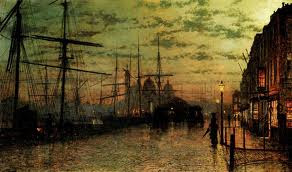The Art Lesson: Contre-Jour
July 06, 2013Hi there!
Today I'm going to write about light, about the contre-jour lighting to be precise.
Contre-jour lighting is a type of backlighting where you place the subject right in front of a bright, sunny sky. In French the phrase literally means “against the day,” a poetic way to express this mysterious and powerful effect.
The term is still in common use among photographers. But cameras can’t deliver this effect as powerfully as painters can, because cameras are unable to respond to a wide enough range of intensities, and the silhouettes tend to go to black. But not if you pay attention!
Artists of the 19th Century did wonders with contre jour. You’ll find it with Royal Academicians like Atkinson Grimshaw, Barbizon painters like Constant Troyon, and American landscapists like Frederick Church. (examples below)
When a form is placed contre-jour, it goes into silhouette. The colors weaken. Shadows stretch forward. Details disappear as the glare of the light spills over the edges of the form. The sun itself often shines from inside the frame of the picture, making the viewer’s eyes squint involuntarily.
Contre-jour is a beautiful and dramatic effect, full of symbolism and mystery. But it doesn't last long and you've got to get with it fast or you're left with a view that doesn't even resemble your motive.
Enjoy the beauty of light!
 |
| "Autumn Morning", Atkinson Grimshaw |
 |
| "Humber Docks", Atkinson Grimshaw |
 |
| "The lady of Shalott", 1878, Atkinson Grimshaw |
 |
| "Beach at Trouville", Troyon Constant |
 |
| "Cotopaxi", 1855, Frederick Church |
Vintage dress, BikBok sheer shirt, Converse sneakers, vintage bag.
Source: gurneyjourney.blogspot.com
Photos by Christian Vadan.





























0 comments